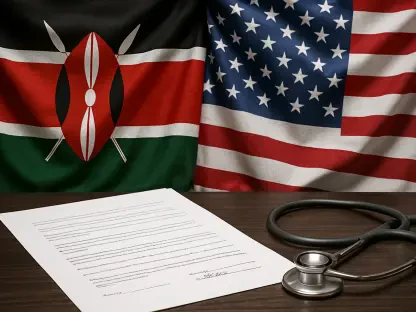Amid the heated debates in Congress over reopening the government and revising health care legislation, a cloud of confusion hangs over the public regarding the true impact of proposed changes in H.R. 1 and the extension of enhanced Advanced Premium Tax Credits (APTCs). Many Americans remain uncertain about which groups stand to gain or lose from these policy shifts, with misinformation often fueling divisive narratives. This uncertainty has been compounded by political rhetoric that sometimes distorts the reality of who is affected by these critical decisions. As lawmakers push to resolve the government shutdown, the need for clear, factual insights into these policies has never been more pressing. This article aims to cut through the noise, examining the data and debunking myths to reveal the primary beneficiaries of efforts to repeal health cuts and sustain vital subsidies.
Unpacking the Policy Landscape
Clarifying Eligibility and Coverage Rules
A significant source of misunderstanding in the health care debate centers on eligibility for programs like Medicaid, Medicare, and Marketplace coverage under APTCs. Contrary to some widely circulated claims, undocumented immigrants are generally not eligible for these benefits, meaning that policy changes in H.R. 1 or APTC extensions do not impact this group. This distinction is crucial, as public discourse often muddies the waters by suggesting otherwise. Data from the Congressional Budget Office (CBO) reinforces that the focus of these legislative efforts lies elsewhere, with specific rules barring undocumented individuals from accessing subsidized coverage. This fact alone challenges many assumptions and redirects attention to the populations actually affected by the proposed changes. The persistent myth that these policies primarily aid undocumented immigrants underscores the urgent need for accurate reporting to guide public understanding and shape informed opinions on health care reform.
Shifting the lens to lawfully present immigrants, such as refugees, reveals a more nuanced but still secondary impact. While reversing H.R. 1 cuts and extending APTCs does offer some protection to this group, CBO estimates suggest that only about 1.4 million lawfully present immigrants—less than 10% of the total projected coverage losses—would be affected by the proposed cuts. This figure pales in comparison to the broader scope of impact across other demographics. The limited scale of benefit for this group highlights that the core focus of these policy debates extends far beyond immigrant communities. Instead, it points to a much larger segment of the population bearing the brunt of potential coverage losses. Addressing these disparities in perception versus reality remains essential to fostering a dialogue grounded in facts rather than speculation or political spin.
Examining the Scale of Impact
When analyzing the broader implications of H.R. 1 and APTC policies, the numbers tell a striking story about the primary group at risk. According to CBO projections, a staggering 14.2 million people stand to lose coverage if the cuts in H.R. 1 are enacted and APTCs are not extended, with approximately 90% of those affected—around 12.8 million—being U.S. citizens. This overwhelming majority underscores that the heart of these legislative efforts is about safeguarding access for citizens rather than any other demographic. The data dismantles narratives suggesting otherwise and places the focus squarely on the domestic population most vulnerable to broad program reductions, particularly in Medicaid. Such clarity is vital for policymakers and the public alike to prioritize solutions that address the most significant areas of need within the health care system.
Beyond the raw numbers, the implications of these coverage losses for U.S. citizens touch on deeper systemic issues. Many of those at risk rely on Medicaid as a lifeline for basic health services, and reductions could exacerbate existing disparities in access to care. The ripple effects might strain emergency services and increase uninsured rates, placing additional burdens on communities already grappling with economic challenges. While the debate often gets sidetracked by discussions of immigrant coverage, the reality is that the vast majority of potential losses affect citizens who depend on these programs for stability. This perspective shifts the conversation toward crafting policies that protect the largest affected group, ensuring that legislative outcomes align with the data-driven needs of the population rather than politically charged distractions.
Addressing Public Misconceptions
Debunking Common Myths
One of the most pervasive myths in the current health care debate is the notion that repealing H.R. 1 cuts or extending APTCs primarily serves undocumented immigrants. This claim has been repeatedly debunked by factual analysis, as eligibility rules explicitly exclude this group from benefiting from such policies. The persistence of this falsehood in public discourse reveals a troubling gap in understanding, with less than half of Americans aware of these restrictions, according to recent surveys. Misinformation like this not only distorts the intent of legislation but also diverts attention from the real issues at hand. Clearing up such misconceptions is a critical step in ensuring that discussions remain focused on evidence rather than unfounded assertions, allowing for more effective policy solutions to emerge.
Another misleading narrative suggests that these policy efforts are mainly geared toward covering lawfully present immigrants, but this too falls short of the full picture. While there is a tangible benefit for this group, the scale is minimal compared to the broader impact, as previously noted with CBO’s estimate of 1.4 million affected. This represents a small fraction of the total coverage losses projected under H.R. 1, indicating that the legislative focus extends far beyond this demographic. Recognizing the limited scope of impact here helps to reframe the conversation, pushing back against oversimplified claims that fail to capture the complexity of health care policy. A more accurate understanding ensures that resources and attention are directed toward the areas of greatest consequence, fostering a more balanced and informed public debate.
Highlighting the True Focus
The data leaves little room for doubt: the primary thrust of efforts to repeal H.R. 1 health cuts and extend APTCs is to protect U.S. citizens, who face the overwhelming majority of coverage losses at 12.8 million individuals. This figure, representing about 90% of the total impact, highlights a clear priority in safeguarding domestic access to health insurance, particularly through programs like Medicaid. Political rhetoric often obscures this reality, but the numbers provide an unassailable counterpoint to misleading claims. Emphasizing this fact is not just about correcting the record; it’s about ensuring that legislative priorities reflect the needs of the largest affected group. Such focus is essential for crafting policies that address the core challenges facing the health care system today.
Looking back at the trajectory of this debate, it’s evident that public confusion stemmed from a mix of misinformation and complex policy details that were not adequately communicated. The reliance on CBO data to clarify these issues proved instrumental in separating fact from fiction. Moving forward, the challenge lies in sustaining this commitment to accuracy, ensuring that future health care reforms are grounded in transparent and reliable information. Policymakers must continue to prioritize clear messaging to prevent similar misunderstandings, while also exploring targeted solutions to mitigate coverage losses for U.S. citizens. By building on these insights, there is an opportunity to create a more equitable and effective health care framework that truly serves those most in need.









